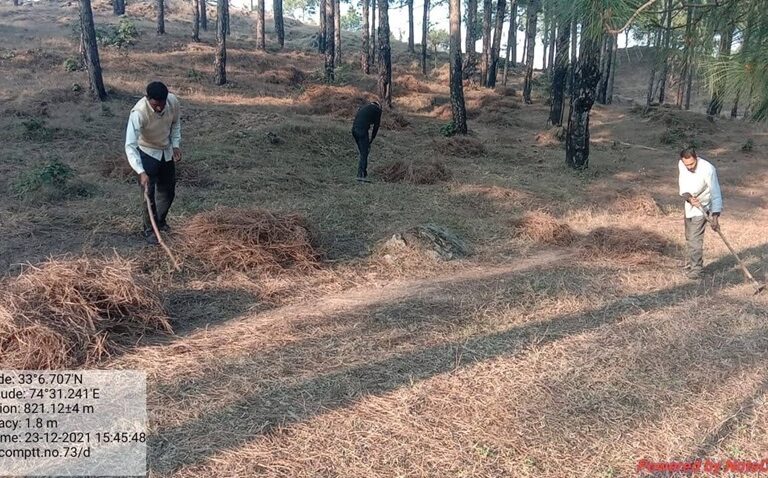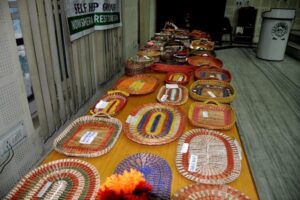Converting Pine Needles From A Fire Risk Into A Livelihood Opportunity
Apr 1, 2024 | Pratirodh Bureau
In Jammu and Kashmir, it is estimated that some two lakh tonnes of pine needles are shed every year (Photo by Rakesh Verma)
- Dry pine needles in Jammu’s forests form a combustible mat, posing fire risks during summer that damage vegetation, wildlife habitats, biodiversity, and impact local livelihoods.
- The forest department of Jammu and Kashmir has launched an initiative which ropes in local residents to collect pine needles and convert them into bio-briquettes and handicrafts.
- Bio-briquettes are a biofuel substitute for coal and charcoal. These briquettes can be used for cooking and heating purposes and are particularly useful in energy-scarce areas, during winters.
As the first rays of the spring sun touch the tall chir pine trees (Pinus Roxburgii) in the dense forests of Sunderbani in Jammu, residents living near the jungle, also get ready to spring into action. They strap on a long cloth called palle in the Dogri language, and several groups comprising both men and women leave their hutments to collect the dry pine needles (locally known as sarmoye) scattered across the forest floor.
“From April till the end of June, we collect these slender pine needles. It helps us generate an income, as the needles are used to create bio briquettes (bio-fuel) and handicrafts,” shared Doulat Ram Uppal, a resident of Sunderbani who leads a self-help group of ten people.

In Jammu and Kashmir, subtropical pine forests account for 16.40% of the total forest cover and are predominantly distributed over the Shivalik range of the Himalayas. Further, the area under chir pine forest in Jammu and Kashmir is 158,813 hectares and occurs at an altitude of 500-1,500 metres all along the Himalayas. The forest extends from Basohli in the east to Poonch in the west, and goes up to Chenab Valley. It occurs in Bhadarwah, Doda, Ramban, Reasi, Udhampur, Samba, Kathua, Poonch, Rajouri, Nowshera, Billawar, and Jammu Forest Division.
Fuelling Forest Fire
In Jammu and Kashmir, it is estimated that around two lakh tonnes of pine needles shed every year. During summers, the shedding of dry needles (the long, slender leaves that grow in clusters) forms a thick mat on the ground, which not only affects the growth of regeneration but also, due to the slow rate of decomposition, the needles act as combustible material during the peak summer season (April to June). The resin content in the needles also enhances fast combustion of dry litter during summer, making the forests vulnerable to fire.
Forest fires damage the vegetation cover and affect wildlife habitats. They cause change in microclimate, loss of biodiversity, and invasion of weeds. These forest blazes can also adversely affect the local livelihoods, besides releasing carbon dioxide, a greenhouse gas responsible for global warming.
Over the past decade, the Jammu and Kashmir region has witnessed thousands of forest fire incidents. From 2002 to 2018, a total of 4,392 forest fire incidents were reported across 6,795 compartments. The divisions of Jammu, Nowshera, and Samba are particularly vulnerable, and they witnessed the highest number of fire incidents. Meanwhile, in the Kashmir region, Bandipora division stands out with the highest number of forest fire incidents. A report published in 2022 claimed that the region has experienced over 1,000 wildfire incidents in the last four years alone.
To combat this problem, the forest department of Jammu and Kashmir initiated a project in 2021, aimed at utilising these chir needles through sustainable management and new interventions. “We started with the Nowshera forest division, which covers around 65,000 hectares of area and about 9,565 hectares of very dense chir forest that is highly prone to forest fire. The local people residing in and around the forest depend upon it for their daily activities like fuel wood, grazing of their cattle, etc. Particularly, communities like Gujjar and Bakkarwal largely depend upon the forest for grass and grazing of their cattle,” Rakesh Verma, Range Officer at Nowshera Forest Division, Jammu, told Mongabay-India.
In the initial phase, the project involved educating forest staff on effective interaction with local communities, a strategy commonly referred to as Joint Forest Management. “We provided training on how to make small artefacts out of the forest waste. As time progressed, our staff honed their skills, producing attractive artefacts that eventually attracted people,” Verma explained.
Sumitra Devi, a mother to two daughters and an active member of a local self-help group from a village in Rajouri district, Nowshera forest division, shared her story, “Listening to tales of women’s achievements on the radio often made me contemplate our village’s reality. Earning a livelihood as a woman seemed daunting, let alone earning enough to educate our children. However, through the income of around Rs. 10,000 monthly, generated from making various handicrafts out of pine needles, I have been able to enroll my daughters in a government school.”
What exactly happens after they collect the needles from the forest? Devi explained, “After collecting the needles from the forest floor, we tie them in the bundles. Following this, we thoroughly clean them using washing powder to remove dirt or any unwanted material. These bundles are thrown in boiling water with neem leaves and glycerine drops. The neem leaves protect the chir pine needles from fungus, and the glycerine helps bring a shine on them. The bundles are kept in water overnight, after which they are shade-dried and ready to braid.”
The women learned to make various handicrafts such as roti boxes, trays with and without wooden bases, dining mats, purses and more, priced at Rs.300 onwards. “These bio-products are distinctly eco-friendly and organic in nature and no chemical is involved in the entire process,” Verma said. However, these products were not easily marketable in conventional settings. After thorough discussions, we decided to introduce the products at local fairs or melas and exhibitions. “We displayed these products at an international fair in Delhi, where the women earned over one lakh rupees in three days. This success was a huge encouragement for other local women to boost their skills and come forward for more training workshops,” he added.
According to data from the forest department, 11 training sessions have been organised in the Nowshera forest division so far and 15 self-help groups are registered in the National Rural Livelihood Mission (NRLM). Around 480 women have been trained in handicraft making.
Although creating handicrafts from the bio waste offered a source of income for local women, the quantity of pine needles utilised in this endeavour remained minimal. The department then introduced another initiative to convert pine needles into bio-briquettes.
Bio-Briquettes From Pine Needles
The forest department first initiated the removal of pine needles from the forest and decided to give controlled burning, a chance. “Given the vastness of the forest, a complete removal is unfeasible. Also, controlled burning again poses environmental risks. This motivated us to seek scientific assistance from IIT Roorkee, which helped us develop a portable manual hydraulic machine for manufacturing bio-briquettes from pine needles. Bio-briquettes are a biofuel substitute for coal and charcoal, mostly made of green waste,” a staff from the forest department explained, on condition of anonymity.
The briquettes require no binding material, are hand-driven. Around 100 grams of crushed pine needles make 80 grams of briquettes. The whole process takes 80 seconds with the machine. These briquettes can be used for cooking and heating purposes and are sold at Rs. 12-15 per kilogram. Even aromatic briquettes are with these machines using Eucalyptus leaves and Vitex negundo.
At present, 15 such portable hydraulic machines are installed in the Nowshera forest division. Around five self-help groups are presently trained in manufacturing bio-briquettes.
Koushal Kumar, head of a self-help group said the consumers of bio-briquettes are mostly the roadside dhabawalas and hotel owners. “Besides selling the briquettes to dhabawalas, we have tied up with five hotels. They order around ten quintals on average every fortnight in winter months. Our members in the group work two hours daily and earn around Rs. 12 to 13 thousand per month,” Kumar said.
According to forest officials, these establishments previously relied on expensive firewood or charcoal. “We persuaded them to switch to briquettes due to their cost-effectiveness, longer combustibility, and minimal smoke production. With just two kilograms of briquettes, these small vendors can sustain their operations for an entire day,” Verma explained.
Bio-Briquettes For Energy-Scarce Areas
The Conservator of Forests, Eco-Tourism, Jammu and Kashmir, Irfan Ali Shah told Mongabay-India that converting harmful forest bio residue into a useful resource for handicraft and energy has great potential to provide sustainable livelihood opportunities to the communities.
“From these experiments, we also observed that the involvement of self-help groups in handicrafts and bio-briquettes promotes gender empowerment and significantly impacts social restructuring. We intend to expand this initiative to other divisions of Jammu that are susceptible to forest fires,” Shah said.
He added that bio-briquettes could prove highly beneficial in areas like Gurez, Tangdhar, Uri, and Sonmarg, where fuel scarcity, especially in winter months, is a perennial issue. According to Shah, although currently operating at a pilot scale, the market potential of this project is substantial.
(Published under Creative Commons from Mongabay-India. Read the original article here)
